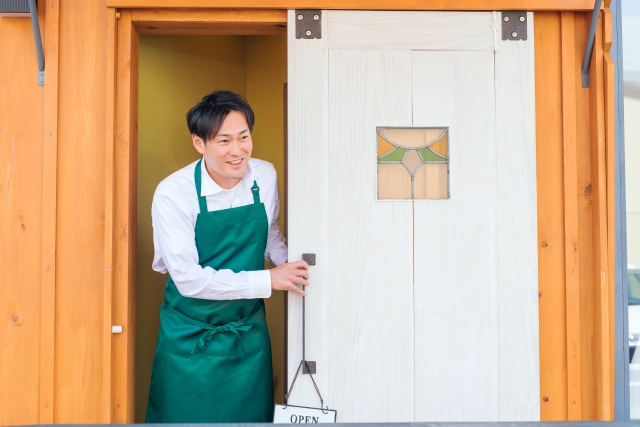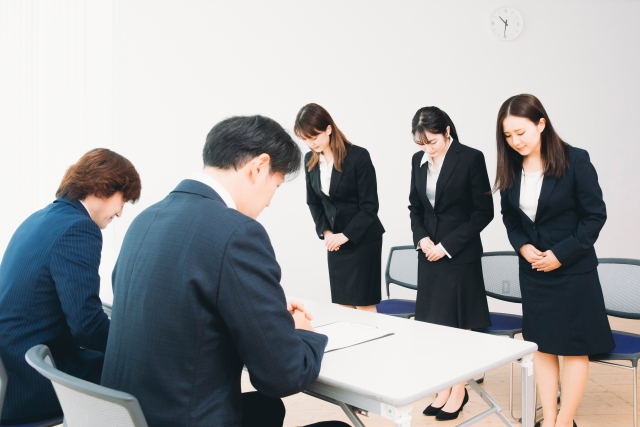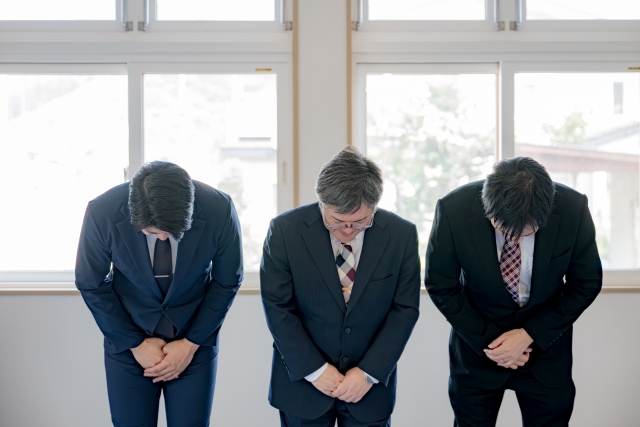INDEX
Bowing, with its various forms for different situations, symbolizes Japanese etiquette.
This practice has been passed down through generations as an eloquent form of expression that goes beyond words, whether to show deep gratitude or convey sincere apologies.
However, perspectives on this traditional etiquette have been shifting in recent years.
Younger generations, in particular, often view it as "too formal" or "restrictive."
In IT startups and foreign-affiliated companies, there's a growing preference for casual greetings and handshakes over bowing.
Japanese people bow as naturally as they breathe.
But will this bowing culture continue into the future?
In this article, we'll take a detailed look at the characteristics and significance of Japanese bowing culture, as well as how it's evolving in modern society.
Why Do Japanese People Bow?
In Japanese culture, bowing is an essential etiquette that expresses respect and reverence toward others.
Bowing is particularly common when interacting with those who are older or of higher status.
In casual relationships, such as between friends, people rarely bow unless there is a compelling reason to do so.
Let's explore the three main purposes of bowing in Japanese culture:
1. Bowing as a Greeting
Bowing while greeting is a daily occurrence in business settings.
For example, people bow when passing their superiors in the office or at the beginning of important client meetings.
When meeting someone of higher status after a long time, bowing not only shows respect but also expresses joy at the reunion.
Instead of waving goodbye, people often bow when leaving meetings as a formal farewell.
Such bowing is an indispensable part of Japanese business etiquette.
2. Bowing to Express Gratitude
Japanese people also use bowing to express gratitude.
For instance, people bow when receiving gifts or souvenirs. In retail settings, staff bow to customers to show appreciation for their purchases.
In the sports world, it's common to see athletes bow to their opponents before and after matches to express gratitude and respect.
This physical expression of gratitude, beyond mere words, is a distinctive element of Japanese culture.
3. Bowing as an Apology
Deeper bows are required when apologizing.
When companies apologize for product or service issues, representatives bow deeply to demonstrate sincerity in their response.
In personal relationships, when someone makes a serious mistake or damages a relationship, they bow deeply to express genuine remorse.
In these situations, bowing serves as important non-verbal communication, going beyond mere formality to demonstrate reflection and willingness to improve.
The Three Types of bowing in Japan
Now that we understand why Japanese people bow, let's explore the three types of bows.
Japanese people primarily perform three types of bows, distinguished by the depth or angle at which they bow their heads.
1. Eshaku : 会釈 (Casual Bow)

Eshaku is the light, casual bow that Japanese people commonly use in everyday life.
It involves a simple motion of lowering the head about 15 degrees, often accompanied by greetings like "good morning" or "excuse me."
This bow can be performed quickly, taking only a few seconds, and can be done naturally without stopping while walking.
The synchronized timing of the verbal greeting and the bowing motion creates a smooth and natural interaction.
Important Points About Eshaku
While Eshaku is convenient for casual greetings, there are certain considerations depending on the recipient and situation.
It's perfect for greeting colleagues and neighbors, but a deeper bow might be more appropriate when addressing superiors or elders.
Among close friends, even more casual greetings are typically used instead of Eshaku.
Particularly when apologizing, Eshaku alone may not convey sufficient sincerity, so a deeper bow is recommended.
When to Use Eshaku
Eshaku is useful in various daily situations.
Common occasions include passing colleagues in the workplace or meeting neighbors on the street.
It's also perfect for expressing quick gratitude, such as when someone exits an elevator first or yields way in crowded spaces.
These subtle bows help maintain smooth social interactions in everyday Japanese life.
2. Keirei : 敬礼 (Formal Bow)

Keirei is a polite bow commonly seen in business settings.
This bow involves lowering the head approximately 30 degrees, creating a more formal impression than Eshaku.
It's typically accompanied by honorific expressions like "ohayou gozaimasu" (good morning) or "moushiwake gozaimasen" (I apologize).
Keirei is recognized as appropriate etiquette for greeting someone for the first time or making light apologies.
Important Points About Keirei
Keirei is primarily used in business and formal settings.
It's rarely used among friends or in casual situations, as it might create an unnecessarily stiff or formal atmosphere.
Additionally, when expressing deep apologies or gratitude, Keirei might appear insufficient, and a deeper bow should be considered.
A crucial aspect of business etiquette is the timing: one should complete speaking before bowing.
The motion of bowing quickly and rising slowly is essential in expressing respect.
The balance between the sequence and speed of these movements is key to creating a courteous impression.
When to Use Keirei
Keirei is most commonly used in business situations.
It's appropriate for meetings with clients, greeting supervisors or company presidents, and various other professional scenarios.
It's also suitable for customer service interactions and when expressing formal gratitude.
It's also suitable for customer service interactions and when expressing formal gratitude. Using Keirei in these situations helps convey both professionalism and appropriate respect for the other party.
3. Saikeirei : 最敬礼 (Deepest Formal Bow)

Saikeirei is the most formal and significant form of Japanese bowing.
It involves deeply bending the body between 45 to 90 degrees, making it a special expression not seen in everyday greetings.
This deep bow is used to express sincere gratitude or apology, as well as during formal ceremonial occasions such as weddings and funerals.
It's one of Japan's traditional etiquette practices used to convey profound respect or remorse that words alone cannot express.
Important Points About Saikeirei
Since Saikeirei is reserved for special occasions, there are several important points to consider.
First, avoid using it in daily situations or among friends.
Inappropriate use can make others uncomfortable or create an awkward atmosphere.
The sequence of movements is also crucial.
Complete your words of apology or gratitude first, then quickly lower your head. After that, slowly raise your body with sincerity.
When performing Saikeirei, maintain focus on the bow itself - avoid looking away or engaging in other actions.
When to Use Saikeirei
In business settings, Saikeirei is used when addressing serious customer complaints to show deep apology.
It's also used during life's significant ceremonies, such as weddings and funerals, to express the solemnity and importance of the occasion.
Furthermore, Saikeirei is appropriate when showing gratitude for significant past favors or kindness.
For example, it might be used to express gratitude to a long-term mentor or someone who provided crucial help at a life-changing moment.
In these situations, Saikeirei serves as an important means of conveying feelings that go beyond words.
Why Do Japanese People Place Such Importance on Bowing?
To foreigners, Japanese bowing culture might seem excessive.
However, this unique form of physical expression deeply reflects Japanese society's values and perspectives on human relationships.
Emphasis on Non-verbal Communication
Japanese culture tends to emphasize non-verbal expressions - body language, facial expressions, and "ma" (the meaningful pause or space between actions) - even more than verbal communication.
Bowing has evolved as an effective means of clearly conveying respect, gratitude, or apology without relying heavily on words.
In Japan, excessive verbal explanation or self-assertion might be viewed negatively as lacking restraint.
Instead, appropriate silence combined with bowing is often preferred.
Maintaining Social Harmony
Japanese society places high value on maintaining smooth interpersonal relationships.
Bowing functions as an essential tool for maintaining and strengthening these relationships.
It also serves as a means of maintaining appropriate social distance - helping to create relationships that are neither too intimate nor too distant.
Awareness of Social Hierarchy
Japanese people tend to be highly conscious of hierarchical relationships based on age and social status.
The different types of bows (Eshaku, Keirei, and Saikeirei) and their varying angles allow people to naturally express these relationships.
This practice is deeply connected to the hierarchical consciousness embedded in Japanese society and has become established as appropriate etiquette corresponding to various social relationships.
Thus, Japanese bowing has been carefully preserved to this day as a means of communication with richer expressiveness than words alone, and as a form of wisdom for maintaining social harmony.
Criticism and Changes in Excessive Etiquette Including Bowing
Recently, particularly among younger generations, perspectives on traditional etiquette have been shifting significantly.
There's growing criticism that traditional etiquette, including bowing, is "superficial" and "overly formal."
Many also view the bowing culture that emphasizes hierarchical relationships based on age and position as "restrictive" and "outdated."
These changes are particularly evident among young people.
Along with opinions that traditional etiquette is "uncool" and "troublesome," there's a growing tendency to avoid excessive formality.
For generations accustomed to social media and online communication, deep bowing and excessive honorific language can create an unwanted sense of distance.
This shift is most noticeable in the IT industry.
Startups and tech companies are increasingly embracing cultures that value flat relationships over rigid etiquette.
Light nods and casual greetings are becoming more common, replacing deep bows.
Moreover, in foreign-affiliated and global companies, handshakes and eye contact are increasingly replacing bows as greeting customs.
However, this doesn't necessarily mean a complete rejection of Japanese traditional etiquette.
Rather, it reflects a search for new communication styles that can flexibly adapt to different situations and people.
My Thoughts on Bowing
As a Japanese person, bowing had become such a natural behavior that it wasn't until I studied abroad in New Zealand and experienced a culture without bowing that I realized, "Oh, bowing is actually a Japanese cultural practice."
For Japanese people, bowing is as natural as breathing.
And I believe there is beauty and practicality in this culture where we can show sincerity through a deep bow when we want to express strong gratitude or make a heartfelt apology.
However, in recent years, I've noticed some negative aspects of this bowing culture becoming more prominent.
The excessive formality of bowing in corporate settings that emphasizes hierarchical relationships, and the perfunctory bows during public apology press conferences seem to have lost the essential element of "facilitating human relationships."
I cannot predict how Japan's bowing culture will evolve in the future.
However, if it continues to be merely a formality and a tool for emphasizing hierarchical relationships, I feel that bowing might eventually fade away as a cultural practice.

Author : Katsu
Born and raised in Japan. After traveling solo to various countries starting at age 20, I was shocked to discover how peculiar Japanese culture and thinking appeared from a global perspective. Now I find these differences fascinating and want to incorporate new cultural perspectives and ways of thinking.
RELATED ARTICLES
Got questions about how Japanese think, act, or some of Japan’s quirky cultural habits? No matter how big or small—drop your thoughts in the comments below!

